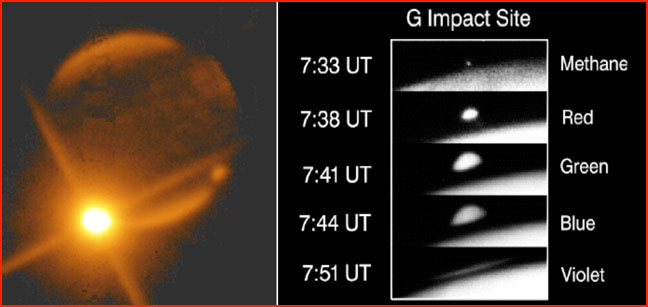
home •
about •
essential guide •
picture of the day •
thunderblogs •
news •
multimedia •
predictions •
products •
get involved •
contact
picture of the day archive subject index
LEFT: Hubble Space Telescope view of the plume from Shoemaker-Levy 9
Fragment G impact, appearing around the limb of Jupiter.
RIGHT: Fragment G impact. Image at 2.34 microns with CASPIR by Peter
McGregor ANU 2.3 telescope at Siding Spring
May 29, 2006
Deep Impact and Shoemaker-Levy 9To place the Deep Impact events in perspective, advocates of the electric comet model remind us of the crash of the comet Shoemaker-Levy 9 into Jupiter in 1994.
For some time now the electrical theorists have noted that the institutionalization of scientific inquiry, in combination with funding requirements, has encouraged a short attention span. The things that do not fit prior theory elicit a momentary expression of surprise, but as the events pass from view they are quickly forgotten. “What we cannot comprehend, we shall forget”.
So it is that already the stupendous explosion produced by Deep Impact—the blast of light that shocked every member of the investigative team—is fading from the consciousness of the investigators. And just two weeks after Deep Impact, all discussion of the equally remarkable advanced flash has ceased. Perhaps none of the NASA scientists knew that the electrical theorists had predicted these events in advance.
Here is an interesting fact. When looking forward to the Deep Impact mission in October 2001, Wallace Thornhill observed: “…the energetic effects of the encounter should exceed that of a simple physical impact, in the same way that was seen with comet Shoemaker-Levy 9 fragments at Jupiter.” We gave the reasoning in our predictions posted early in the day, July 3: The energy of the explosion will not come just from a collision of solid bodies, but will include the electrical contribution of the comet.
Thornhill had not forgotten an earlier surprise, though it appears that no one involved in Deep Impact remembered what happened when comet Shoemaker-Levy 9 approached Jupiter in the summer of 1994. Astronomers expected the encounter to be a trivial event. “You won’t see anything. The comet crash will probably amount to nothing more than a bunch of pebbles falling into an ocean 500 million miles from Earth.” Then came the encounter and an about face. As reported by Sky & Telescope, “When Fragment ‘A’ hit the giant planet, it threw up a fireball so unexpectedly bright that it seemed to knock the world’s astronomical community off its feet.” So a brief summary of some of those earlier events are provided below. For a more detailed article see Comet Tempel 1's Electrifying Impact.
The Hubble Space Telescope (HST) detected a flare-up of fragment “G” of Shoemaker-Levy long before impact at a distance of 2.3 million miles from Jupiter. For the electrical theorists this flash would occur as the fragment crossed Jupiter’s plasma sheath, or magnetosphere boundary. Thornhill comments: “A plasma sheath, or ‘double layer’, is a region of strong electric field, so the outburst there of an electrified comet nucleus is expected. The outburst was a surprise to astronomers. Hubble’s Faint Object Spectrograph (FOS) recorded strong emissions from fragment ‘G’ of ionized magnesium but no hydroxyl radical (OH), expected from water ice”. Also, after the flare-up in magnesium emissions there was a “dramatic change in the light reflected from the dust particles in the comet”. All told, the similarities to the Deep Impact flash are remarkable.
Just after the impact of SL-9 fragment “K”, HST detected unusual auroral activity that was brighter than Jupiter’s normal aurora and outside their normal area. Radiation belts were disrupted. There were unexpectedly bright X-ray emissions at the time of impact. But one mystery was never explained satisfactorily: Early impact events were hidden from the Earth behind Jupiter’s limb. However, the Galileo spacecraft was positioned 150 million miles away from Jupiter at an angle that gave it a ringside seat for these events. But Earth-based observatories saw some of the impacts start at the same time Galileo did. “In effect, we are seeing something we didn’t think we had any right to see,” said Dr. Andrew Ingersoll of Caltech. “...it seems clear that something was happening high enough to be seen beyond the curve of the planet,” said Galileo Project scientist Dr. Torrence Johnson of JPL.
None of these discoveries is surprising if comets are highly electrically charged with respect to their environment. Radio astronomers had expected radio emissions from Jupiter at high frequencies to drop because dust from SL-9 fragments would absorb electrons from the radiation belts, where the electrons emit synchrotron radiation. Instead, observers were surprised to find that emissions around 2.3 GHz rose by 20-30%. “Never in 23 years of Jupiter observations have we seen such a rapid and intense increase in radio emission,” said Michael Klein of JPL. “Extra electrons were supplied by a source which is a mystery.” It never occurred to anyone that the charged comet was the source of the electrons.
Will the rapid exclusion of uncomfortable facts continue as we await data analysis of Deep Impact? In tomorrow’s Picture of the Day, we shall list the urgent questions yet unanswered as NASA officials have fallen into silence, even withdrawing much of the visual material formerly available on the Deep Impact website.
See also:
Jul 05, 2005 Deep Impact—First Impressions
Jul 06, 2005 Reconsidering Comet Wild 2
Jul 07, 2005 The Meaning of Deep Impact
Jul 08, 2005 Deep Impact—The Smoking Guns?
Jul 15, 2005 The Missing Water of Comet Tempel 1________________________________________________________________________________________________
Please visit our Forum
The Electric Sky and The Electric Universe available now!

|
|

|
EXECUTIVE EDITORS:
David Talbott, Wallace Thornhill
MANAGING EDITOR:
Michael Armstrong
CONTRIBUTING EDITORS: Dwardu Cardona, Ev Cochrane,
C.J. Ransom, Don Scott, Rens van der Sluijs, Ian Tresman
WEBMASTER: Michael Armstrong
Copyright 2006: thunderbolts.info
![]()
home •
thunderblogs •
forum •
picture of the day •
resources •
team •
updates •
contact us

